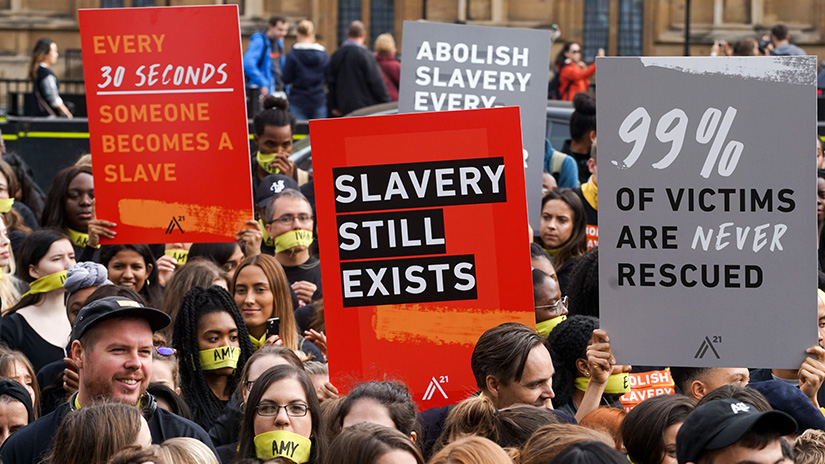Healthcare consumers are progressively more informed about modern slavery, hearing scandals like Xingjiang cotton, or recent reports of forced labour in Malaysian company Top Glove.
Stakeholders have cause to be concerned about modern slavery in their supply chains. The Global Slavery Index says there were 24.9 million people in forced labour around the world in 2016. This is almost as many people as live in Australia.
Faith-based organisations, standing for humanitarian values, should have an ethical supply chain from manufacture through to delivery. Environmental, social and governance (ESG) factors are key brand differentiators, dovetailing with the values of faith-based businesses.
There are not only market demands and moral requirements, but legal obligations as well.
The Australian government takes ESG factors seriously. They’re aiming to suppress unethical supply chains, taking the ground that Australian organisations have a duty of care to combat modern slavery.
Modern Slavery Statements – Minimum Disclosure or Practical Action?
Enter the Modern Slavery Act 2018 (Cth). It states:
This Act requires entities based, or operating, in Australia, which have an annual consolidated revenue of more than $100 million, to report annually on the risks of modern slavery in their operations and supply chains, and actions to address those risks. Other entities based, or operating, in Australia may report voluntarily.
The first batch of Modern Slavery Statements were published to the Modern Slavery Register last year, and the results were less than satisfactory.
The Australian Council of Superannuation Investors (ACSI) analysed 151 Modern Slavery Statements, and rated them on a ‘quality score’ based on the disclosure requirements in the Modern Slavery Act.
They found that the main aim of ASX 200 listed businesses was ‘ticking the boxes’ without making real change.
By the ACSI’s quality score, statements could achieve up to 41 points. The median score sat firmly in the 10-15 points group, corresponding to a 30% score. We’ll remember from school days that this falls well short of a pass.
The ACSI reported that the statements had:
- Low understanding of the relevant legal framework and world-standard language (e.g. the UN Guiding Principles)
- Little focus on remediation, and
- Little attention paid to practical outcomes.
The last issue was central in companies’ failure to address modern slavery risk. Most actions taken consisted of policies written, opinions gathered, paperwork filled out, and training sessions held.
As reporting deadlines approach, ASX 200 companies need practical outcomes to show progress from the last reporting period.
Four Steps for a More Effective Modern Slavery Statement
We recently spoke with risk management specialist iPRO, who provide a platform for assessing modern slavery risks. They said:
A lot of organisations fear the consequences of lifting the cover on a less-than-perfect result. Instead, we take a continuous improvement approach, that identifies areas for improvement so that you can take meaningful action.
A risk assessment that dives deeper than your first supply tier is the first step to start this approach of continuous improvement. This assessment will give you a line of sight from your suppliers to their suppliers.
Once you’ve completed a risk assessment, the next step is taking action.
Taking action doesn’t necessarily mean cutting off relations with all high-risk suppliers. Sometimes, an entire industry will be at risk of modern slavery, and swapping suppliers may not be the best approach.
Instead, taking action starts from within and spreads from there. When your staff actively support your modern slavery policy, you can incentivise your supply network to do the same.
Taking action on your risk assessment also means actively searching for forced labour in your supply chain.
Your Modern Slavery Statement is proof of your hard work. The following steps will ensure it correctly represents your actions, showing what you’ve worked to achieve.
1. Set your Modern Slavery Remediation Actions
What are you going to do if you find a case of modern slavery? What’s the process?
Do you start by finding alternate suppliers, or alternate countries of origin? Or do you work with your suppliers to address the forced labour, making real change? Assess your best course of action – will you meet the issue head on, or will you steer clear of high-risk areas?
It’s important that your protocol and measures are written out.
A great example of clear remediation actions is found in the Woolworths Group Modern Slavery Statement 2021. This statement has been widely acclaimed as transparent and results-focused.

1 Human Rights Due Diligence Maturity Framework, Woolworths Group Modern Slavery Statement 2021, P. 21
2. Incentivise Modern Slavery Risk Management
It’s also important for remediation policies to be followed.
Remember, those at the front line of the business must juggle conflicting priorities when following modern slavery directives.
Essential to solve this conflict is a list of practical outcomes that drive change.
For example, how many of your stakeholders are now aware that modern slavery is a key issue in your organisation? How many suppliers are working with their own supply chain to root out modern slavery?
Once you have your list, work with the whole business to set the outcomes as C-suite and employee Key Performance Indicators.
In our recent webinar with iPRO, Gina Herbert introduced the idea of a supplier reward consisting of “a digital badge showcasing compliance, that [suppliers] can then use to prove their level of commitment to the other external clients that they may service.”
Later in the webinar, Paul Miles spoke of the clear benefits of ensuring that your brand values are backed by clear evidence of modern slavery remediation.
3. Keep on Talking about Modern Slavery
Then, keep up the focus on modern slavery risks through staff education and awareness.
Put modern slavery as an item to talk about in board meetings, in company newsletters, in informal discussions. Your investors and stakeholders need to be weary of you talking about it before your focus will make an impact.
Gina sees forward movement as brave and commendable:
After sharing audit reports, transparency both internally and externally is going to be critical in this conversation. It is brave… So even if you’re assessing and the picture [of your supply chain] is ugly, you should be commended because that’s the only way you’re going to be able to take meaningful action.
Increasing your team’s awareness of modern slavery is critical as part of increased ‘internal transparency’. Paul recommended sharing our webinar to your team as an introduction to modern slavery risks.
4. Fine Tune Your Modern Slavery Statement
Lastly, use the government’s language when writing your statement, so the results you show align with the requirements of the Modern Slavery Act. The length and design of your statement are immaterial compared with the content, how you analyse and report your actions based on world-standard criteria.
So, get your legal advisors to learn the language of the UN Guiding Principles and teach it to you, your executives, and your writing team. Then write the practical steps you’ve taken for remediation in that language.
These steps could include:
- Risk analysis completed
- Supplier conversations held
- Whistleblower policies written, and
- Incentives implemented based on modern slavery outcomes.
Specifically pointing out practical steps will prevent the problems highlighted in the ACSI’s report on current Modern Slavery Statements.
Making Progress on Modern Slavery
The main aim of the Modern Slavery Act was to spur action and drive conversation in Australian businesses. The government wants progress made, even if it is incremental progress, instead of a race to disclose the least possible information necessary.
As faith-based, even if you’re not an ASX 200 company, walking the modern slavery talk helps you to represent your core values in a practical way. Investors and consumers will take notice.
If you discover modern slavery in your supply chain, your groundwork will serve you well. The process you’ve put in place will become a tool in the hands of your staff to properly deal with incidents as they arrive. Also, a situation that has been successfully handled by employees is unlikely to appear as a ‘reveal’ in the media.
As Gina emphasised, our focus is “the importance of lifting up that cover and taking that first brave step” towards combating modern slavery.
It’s not an easy process, but the steps above should provide an excellent starting point. The key is starting today.
Download our webinar summary for more detail on how to combat modern slavery with focused reporting.






